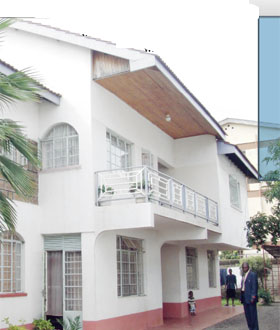As land in urban centres increasingly gets scarce, developers know exactly where and how to wave their architectural magic wands, writes Harold Ayodo.
Investors in real estate are seeking old homes in upmarket areas for renovation instead of constructing new ones. No wonder property experts concur that the proverb ‘old is gold’ also applies in the sub-sector as these ancient buildings, often in serene atmospheres, have several advantages.
 |
A renovated house in Kisumu. Investors in real estate are scrambling for old houses which they renovate and sell at a profit.
[PHOTOS: JAMES KEYI and Jonah Onyango/Standard] |
For instance, architects say renovations preserve the architectural history of the homes and that this is probably cheaper compared to constructing a new home. Batimen Group principal architect, Kimani Guchu says that well developed infrastructure is among the reasons a certain clientele prefer antique homes.
"Some prospective home owners are willing to part with colossal amounts of money to buy old property," Guchu says.
A section of investors in real estate who purchase the old homes renovate them to incorporate modern building services then re-sell at profits. A number of established architectural firms are doing brisk business by reconstructing colonial homes. Guchu says Old Muthaiga, Karen, Loresho, Kyuna and Spring Valley are among the areas in Nairobi where old homes are being refurbished in accordance with proper planning regulations. Renting a three bedroom apartment in Spring Valley could cost Sh75,000 per month, while a 1.5 acre prime plot in Karen, without a building on it, can go for as much as Sh25 million.
Concept not new
Renovation of antique buildings is, however, not a new concept. The Government last year announced intentions to refurbish the State House in Nairobi, which was constructed in 1907, at a cost of Sh400 million. The President’s official residence stands on an estimated 741 acres of prime land. Last year, valuers estimated the land alone to be Sh37 billion.
The ancient Nairobi National Museum was also recently renovated at a cost of Sh8 million.
The thirst for old homes is not only present in the capital city but also in major towns countrywide. Mary Sombe, a marketer with Ounga Commercial Agencies says most of their clients who embrace ancient property renovate them to increase value. "Some refurbish them to introduce modifications then sell the property at a profit," she says.
Emerging investors are increasingly preferring to buy refurbished homes because they are more spacious compared to new ones. "Building new houses also takes a long time which investors who want quick returns on their investment don’t have time for," says Sombe. "A few other people buy old homes and fit them with Elizabethan furniture to maintain the old but cosy look."
Kisumu’s colonial homes
In Kisumu for instance, the wealthy are attached to homes in Milimani, Tom Mboya and Riat Hills estates. Owners would rather renovate them than move out.
"The current demand for homes in Kisumu outstrips supply and for some owners, renovation means building additional houses within the same compound, which is often large," says Sombe.
Stay informed. Subscribe to our newsletter
"Renovation also enables homeowners to introduce latest developments in design to their homes, and it is also cost effective."
She adds that the Government, however, levies taxes on people who dismantle old houses especially in Milimani estate where such homes occupy larger parcels of land.
Additionally, investors in this city’s real estate are turning dilapidated government houses into palatial homes.
Gwili Consultants managing director, John Ogam says, "We are impressed with the increasing number of clients who want to buy government houses in the upmarket Milimani area for up to Sh4 million,"
Prices of old houses in Milimani depend on their sizes and plot acreage. Sombe says the appetite for colonial government homes in the lakeside town follows the rising demand for cosy houses in the area.
Buyers renovating colonial homes are re-selling them at Sh8 million, which is the lowest price for a good modern house in Milimani.
The serenity of Milimani and its history of security, availability of piped water and in-roads makes even its dilapidated houses hot in demand. Other areas in Kisumu that are also hot property among investors are Nubian, Okore and Moscow estates. Homeowners who want to attract more rent from their property prefer giving them a face-lift before letting them out.
Experts concur that there are several factors that are making real estate investors scramble for the ageing homes.
Superior infrastructure
"The infrastructure of the areas where the homes are located are well developed in regard to roads, sewers, telephone and electricity," says Guchu. "The physical planning in the areas is also well articulated allowing space, serenity and a high degree of security. Most of these old properties are architecturally rich and home owners love to maintain that aura."
In Eldoret, the concept is also spreading fast. Property Point managing director, Simon Lilan, says antique homes in the town are hot cakes because they are near to town where most services are located and they are also architecturally rich. "Homes in places like Eastern Avenue have hence attracted a large number of investors," he says. "But owners who are attached to the property for sentimental reasons are not ready to let go."
Lilan, who is also an Advocate of the High Court, notes that other antique homes in Eldoret are located in lower parts of Pioneer, West Indies and Elgon View estate.
Cost of renovation
The cost of renovating an old home could run into thousands or millions of shillings depending on the anticipated improvements. Architect Guchu says, "It may take three to six months to renovate a bungalow depending on the materials and technology used and the extent of renovations."
Architects, however, say new houses are also good because owners can be certain of improved technology and structural integrity. Experts believe the scramble for antique homes near the Central Business Districts would reduce if local authorities developed infrastructure in other estates.
 The Standard Group Plc is a
multi-media organization with investments in media platforms spanning newspaper
print operations, television, radio broadcasting, digital and online services. The
Standard Group is recognized as a leading multi-media house in Kenya with a key
influence in matters of national and international interest.
The Standard Group Plc is a
multi-media organization with investments in media platforms spanning newspaper
print operations, television, radio broadcasting, digital and online services. The
Standard Group is recognized as a leading multi-media house in Kenya with a key
influence in matters of national and international interest.
 The Standard Group Plc is a
multi-media organization with investments in media platforms spanning newspaper
print operations, television, radio broadcasting, digital and online services. The
Standard Group is recognized as a leading multi-media house in Kenya with a key
influence in matters of national and international interest.
The Standard Group Plc is a
multi-media organization with investments in media platforms spanning newspaper
print operations, television, radio broadcasting, digital and online services. The
Standard Group is recognized as a leading multi-media house in Kenya with a key
influence in matters of national and international interest.







